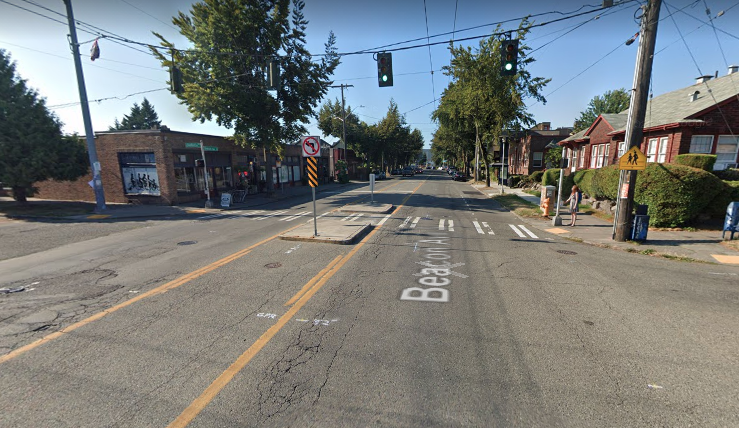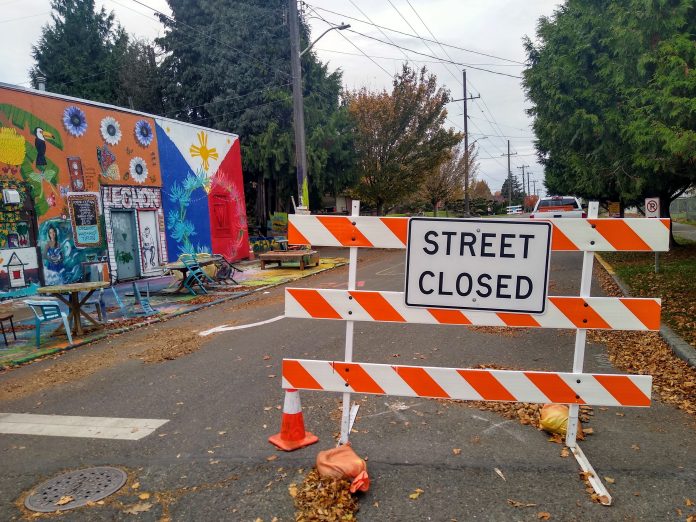
Beacon Hill, Delridge, Highland Park, and Bell Street Park are next up for permanent upgrades after Greenwood.
In the next few weeks, the Seattle Department of Transportation (SDOT) will start work on upgrades to the 1st Avenue NW neighborhood greenway in Greenwood, the first set of permanent improvements made to Seattle’s Stay Healthy Street network. Dropping “Stay” from the name, “Healthy Streets” will replicate the signed restrictions on through vehicle traffic that were implemented in response to the Covid-19 pandemic, with “Street Closed” signage that allows people walking and rolling to use the roadway instead of being restricted to the sidewalk. Painted markings and planter boxes will take the place of A-frame signs and traffic control barrels.
Since it is the first Healthy Street to be constructed, the changes in Greenwood are notable because that street will become the de-facto prototype for the rest of the Healthy Street network. Last year, Mayor Jenny Durkan committed to making 20 miles of the approximately 25 miles of open neighborhood streets permanent, but since than it’s been less than clear what that would look like and what benefits the city’s residents would see from that investment.
These 2021 upgrades to 1st Avenue NW will only be seen between N/NW 73rd Street and N/NW 79th Street. A second phase of the Healthy Street is planned to be installed all the way up to N/NW 100th Street, but not until next year. It wasn’t expected that the work would be broken up in this way; early this year SDOT had announced its intentions to construct all 20 miles of permanent improvements by the end of the year, a promise that seemed ambitious when it was announced.
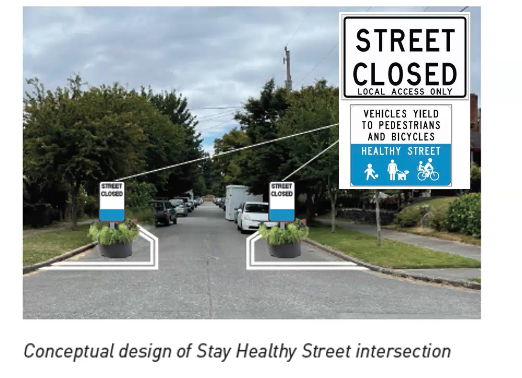
In addition to the intersection treatments and traffic calming features along 1st Avenue NW itself, SDOT is adding traffic calming along streets that intersect this Healthy Street. N/NW 73rd Street, which nearby residents in community meetings brought up as an “unofficial arterial” with heavier, faster traffic than adjacent streets, and where the Healthy Street ends at a T intersection, will see three paint-and-post traffic circles with speed cushions between them. N/NW 79th Street, which sits adjacent to St. John Catholic School, will see speed cushions and relocated stop signs for increased visibility. These are improvements intended to impact how fast people are going on the Healthy Street but also obviously improvements in their own right, and have apparently come about through the community engagement process.

As for the rest of the project up to N/NW 100th Street, slated to go in next year, it’s unclear what the traffic calming features will look like, but so far the SDOT hasn’t proposed to add any traffic diversion infrastructure to the street, any hardscape that would prevent someone from driving from one end of the corridor to the other, behavior that’s encouraged by the placement of stop signs along the neighborhood greenway only for cross-streets. Traffic diversion infrastructure is noticeably scarce along Seattle’s neighborhood greenway network, and the Healthy Street upgrades would be an opportunity to add it.
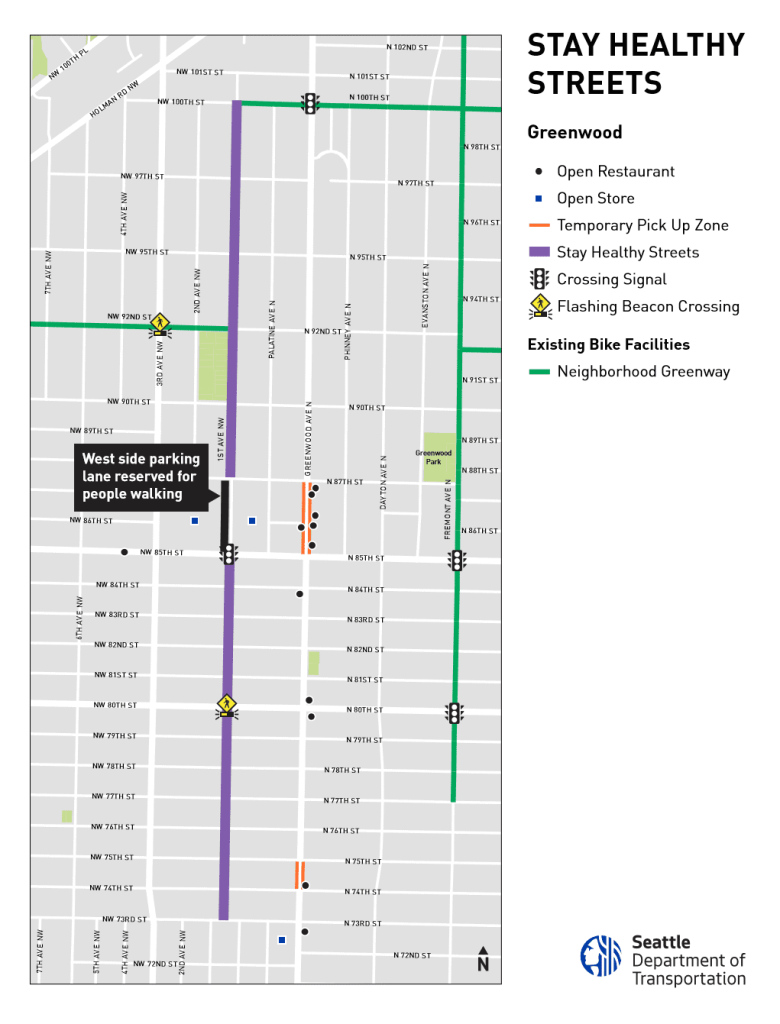
After Greenwood, the next street in line for permanent Healthy Street improvements is the Beacon Hill neighborhood greenway. The northern segment of that street, which connects the Mountains to Sound Trail with a trail alongside Jefferson Park, will likely be the focus of any first phase of upgrades — SDOT conducted a site visit that focused on that segment earlier this summer. The southern portion, between Jefferson Park and S Lucile Street, a connection to Georgetown, would be upgraded later.
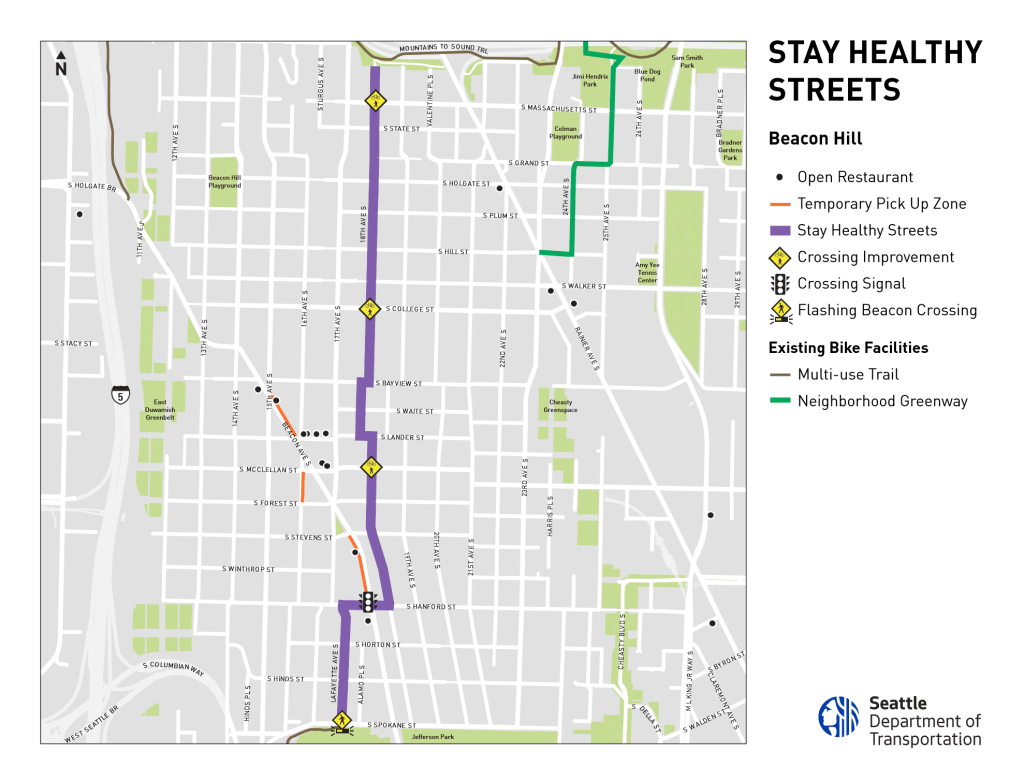
The Beacon Hill Healthy Street upgrade will include many of the same features as are being added in Greenwood: speed cushions, beefed-up intersection signage, and possibly new traffic circles. But also discussed has been the possibility of adding a traffic diverter at Beacon Ave S and S Hanford Street, the spot where the Beacon Hill Stay Healthy Street meets Beacon Hill’s main business district. There’s already a traffic signal at Hanford, but triggering the signal when you’re on a bike is not super easy. An improved bike detection system could be paired with a restriction for drivers on continuing on Hanford across Beacon Avenue. This will likely be an improvement, but isn’t really a substitute for a diverter along the street in a neighborhood since most drivers are heading to the arterial anyway.
As for the rest of the Healthy Street network? Things are even less clear. Currently, SDOT has a little over $2.6 million to make these improvements, including $2.5 million from the federal American Rescue Plan Act pandemic relief allocation. That doesn’t appear to be enough to do all 20 miles, and SDOT’s Ethan Bergerson says they are “in the process of determining how to fund it more sustainably.” Previously, SDOT had proposed to divert funds to Healthy Streets from a set of bicycle master plan projects that likely wouldn’t be able to move forward before the end of the Move Seattle Levy because they didn’t have full funding. That idea was not received well by either the Bicycle Advisory Board or the Move Seattle Levy Oversight Committee but it appears to still be on the table.
Bergerson did say that SDOT is prioritizing Delridge and Highland Park Healthy Street and the Bell Street Park Healthy Street behind the Greenwood and Beacon Hill ones. But it’s not known how much additional funding will be needed for the program because outreach on what the improvements will look like is still ongoing. But policymakers will likely want to know what funding is going toward before allocating more. So far, it’s not clear that allocating more money to Healthy Streets would be better than funding other, more well-established bike and pedestrian improvement programs. As crews start to work their magic in Greenwood and Beacon Hill, that may change.
Ryan Packer has been writing for The Urbanist since 2015, and currently reports full-time as Contributing Editor. Their beats are transportation, land use, public space, traffic safety, and obscure community meetings. Packer has also reported for other regional outlets including BikePortland, Seattle Met, and PubliCola. They live in the Capitol Hill neighborhood of Seattle.

